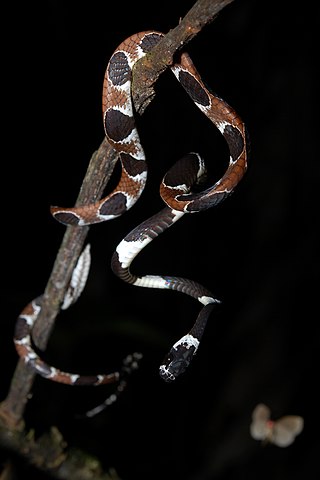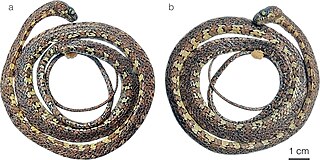
The Natricinae are a subfamily of colubroid snakes, sometimes referred to as a family (Natricidae). The subfamily comprises 36 genera. Members include many very common snake species, such as the European grass snakes, and the North American water snakes and garter snakes. Some Old World members of the subfamily are known as keelbacks, because their dorsal scales exhibit strong keeling.

The Colubrinae are a subfamily of the family Colubridae of snakes. It includes numerous genera, and although taxonomic sources often disagree on the exact number, The Reptile Database lists 717 species in 92 genera as of September 2019. It is the second largest subfamily of colubrids, after Dipsadinae. Many of the most commonly known snakes are members of this subfamily, including rat snakes, king snakes, milk snakes, vine snakes, and indigo snakes.

Geophis is a genus of snakes in the subfamily Dipsadinae of the family Colubridae of the superfamily Colubroidea. Species in the genus Geophis are commonly referred to as Latin American earth snakes. The genus consists of 53 distinct species.

The graceful snail-eater, is a non-venomous snake found in the northern part of South America . No subspecies are currently recognized.

Atractus is a genus of colubrid ground snakes in the subfamily Dipsadinae. The genus includes more than 140 distinct species.

Catesby's snail-eater, also commonly known as Catesby's snail sucker, is a nocturnal species of nonvenomous snake in the family Colubridae. The species is native to northern South America.

Mastigodryas is a genus of colubrid snakes. Like some other colubrids, they are commonly called racers. It is a Neotropical genus, with members distributed from Mexico to Argentina and several islands in the Caribbean. Some authorities use the older generic name, Dryadophis, for these species.

Dipsadinae is a large subfamily of colubroid snakes, sometimes referred to as a family (Dipsadidae). They are found in most of the Americas, including the West Indies, and are most diverse in South America. There are more than 700 species.

Pseudoxenodontinae is a small subfamily of colubroid snakes, sometimes referred to as a family (Pseudoxenodontidae). They are found in southern and southeastern Asia, from northeast India to southern China and south into Indonesia as far east as Wallace's Line. There are 10 species in 2 genera. Most are very poorly known, such that Pseudoxenodontinae is one of the most poorly known groups of snakes.

Sibon is a genus of snakes found in northern South America, Central America and Mexico.
Dipsas pratti, known commonly as Pratt's snail-eater, is a species of arboreal snake in the subfamily Dipsadinae of the family Colubridae. The species is endemic to northern South America.

Apostolepis is a genus of snakes in the subfamily Dipsadinae. However, the familial placement differs among sources. It has also been placed in the family Colubridae, subfamily Dipsadinae or Xenodontinae, or in the family Xenodontidae. The genus Apostolepis is endemic to South America.
Tretanorhinus is a genus of snakes in the subfamily Dipsadinae of the family Colubridae.

Sibon irmelindicaprioae is a species of nonvenomous snake in the subfamily Dipsadinae. It is endemic to Panama. The discovery was made by the Ecuadorian biologist Alejandro Arteaga and the Panamanian biologist Abel Batista in 2023. Sibon irmelindicaprioae belongs to the genus Sibon, and subfamily Dipsadinae. This is also called DiCaprio’s snail-eating snake.
Dipsas welborni is a non-venomous species of snake in the subfamily Dipsadinae. It is found in 26 localities along the Cordillera del Cóndor in south-eastern Ecuador(provinces Morona Santiago and Zamora Chinchipe) and northern Peru. The species occurs over an estimated area of 10,521 km2 and has been recorded at elevations 853–1843 m above sea level.












